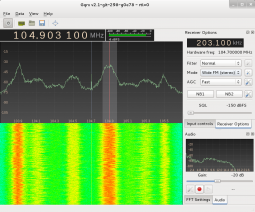Kali Linux is a penetration testing version of Linux. Penetration testing versions of Linux are distributions that come with various software that allows one to test the vulnerability of networks and computer systems to hackers. However, very recently Kali has added a section for SDR radio. This new section includes a pre-built version of GNU Radio as well as other utilities for the RTL and some other SDRs. The release includes the following :
- kalibrate-rtl
- gr-air-modes
- RTLSDR Scanner
- gr-scan
- rtl-sdr
- Gqrx
- GR Extras
- gr-baz
- gr-osmosdr
- gr-iqbal
- gr-fcdproplus
- UHD support
- HackRF support
- RTL2832U support
- Funcube Dongle Pro+ support

My experience with Kali was everything was pretty much plug and play with the RTL Dongle. Just plug the dongle in, get Kali going, and start the Gqrx program if you want to a quick test of your setup. GNU Radio started up easily also. GNU radio does have a bit of a learning curve, but there are plenty of resources to be found around the web if you want to tinker with it.
So you say so what, I still gave to install Linux on my PC! Calm down, you don’t have to. If you have a 4 to 8 GB usb stick lying around you can create a Kali live boot usb stick. This will allow you to boot and use Kali from the usb stick without bothering your windows install by following these instructions. You only need to follow the three steps listed for imaging Kali on a Windows machine. It’s actually quite simple. If you have a fairly modern desktop or laptop, you should be able to boot from an attached USB device. This is accomplished on a large number of systems by tapping the F12 key on boot-up, but this could be different for your PC. If you are comfortable with messing with your PC’s BIOS, you can set your PC to boot automatically from am attached USB device.
Be aware, that once Kali boots up and you get to the start menu, do not select Install. This will cause Kali to install Linux on your PC. You can back out of it at a certain point, but if you continue through the process Kali will install. Now if you want to install Kali, it will allow you to create a dual boot system with Linux installed along side of Windows. So if you don’t intend on installing Kali, just pick the Live option from the menu. One further step you might want to take is to follow the instructions on the installation page on adding Persistence to your usb boot stick. The reason you want to do this is that when you boot Live no settings are kept between sessions. For example if change the screen resolution, the settings won’t be there the next time you start the Live Kali session.
Kali Linux lets you dive into GNU Radio with minimal hassle. So get out there and start building.

Hi
I would like to know if KALI has a BVD-T reception program.
If yes, there would be a possibility to use the RTL stick for SDR on Word program
and as DVB-T on KALI
Is that possible?
Tnx for a reply
René
Rene walter,
i get 32 available(several already installed) dvb packages..
decoders/streamers/scanners/etc
Another option that won’t cause you to lose simultaneous access to your computer is to use virtualization like Oracle’s Virtual Box at https://www.virtualbox.org
I reccomend Vmware player and workstations over virtualbox as virtualbox uses a java base and therefore doesn’t run quite as quick or as smooth as vmware does. Just my personal opinion 🙂
VirtualBox doesn’t have anything to do with Java, it is open source and everyone could check the code base. It works very well on many platforms.
VirtualBox is written in C, C++, and assembly.
en.wikipedia.org/wiki/VirtualBox
I âme only interested in programs for rtl-dongel that wil be for my macbook pro with retinadisplay
.
Please respond
WHY does HRS publish articles by TIME instead of DATE???
I really don’t CARE what time of DAY it was POSTED , BUT
how OLD the article is…
It’s like open a book to the copyright page, and seeing
Copyright @ 5:45PM…
Hello guys… I will have a try